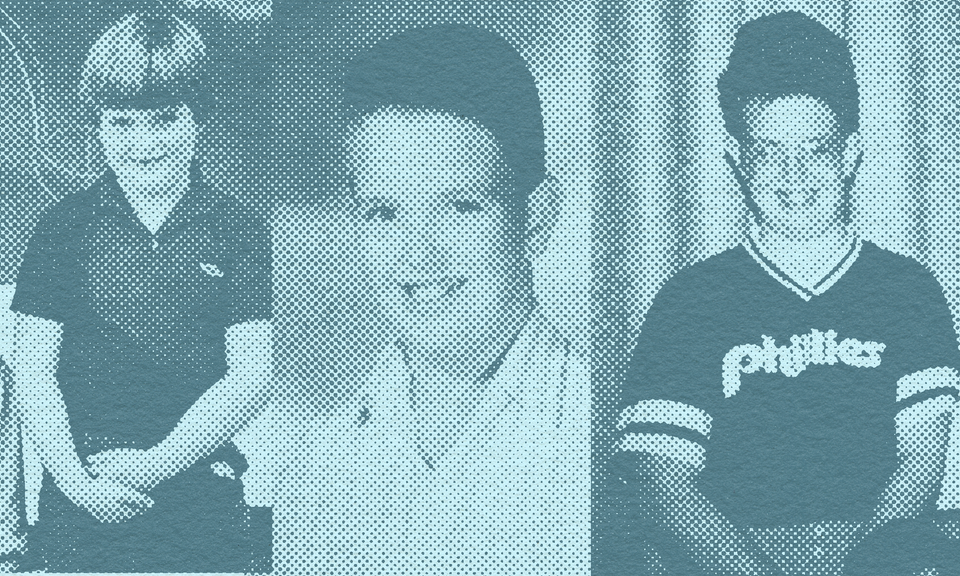Husky

A word that echoes
It starts with a single word: husky. For most people, it conjures images of a majestic, blue-eyed sled dog. For me, it’s the ghost of the 1980s Sears boy’s department fitting room. The word haunted my back-to-school shopping trips, shouted across the store like a distress signal: “Do you have any husky sizes?” I swear the entire mall could hear it.
This is the story of growing up as the big kid—big in every way. Taller than my coaches, wider than my desks, always conscious of how much space I took up. It’s also about how clothes, which should be a form of self-expression, instead became a lifelong battle for dignity and confidence.
Back-to-school and the curse of the husky section
Back-to-school shopping was supposed to be exciting. My mom, an Avon rep who lived for fashion, would take my sisters and me on these epic outings. We'd hit up stores like Sears and JCPenney, where racks of possibilities were waiting—except for me. My size lived in the husky section, a corner of the store with jeans that had the subtlety of a foghorn.
Why husky? Why not just call it big? Or tall? Or, if we’re being honest, fat? Husky was a word designed to sound strong and wholesome, but to me, it was just a different way of saying other.
The salesperson would confirm it loudly: “Yes, we have husky sizes in the back,” like they were retrieving a rare artifact. Meanwhile, I’d be busy wishing the floor would swallow me whole.
That word, stamped on every pair of jeans and jacket, wasn’t just a label. It was a reminder: you don't fit. Not in the clothes, not in the expectations, not in the neat categories other kids seemed to occupy effortlessly.
Thankfully, by the mid-2000s, husky quietly disappeared from most labels. Why? Not because the fashion industry had a collective epiphany about body positivity. No, it was about optics—about not reminding kids that their bodies were problems. Still, I’ll take the win.
Teenage uniforms and dress-down dread
High school uniforms? Lifesavers. When you’re already self-conscious, the last thing you want is more decisions about what to wear.
But then there were dress-down days.
My first dress-down day caused a full-blown panic. I stared into my closet, knowing whatever I wore would define my social standing among a sea of strangers. My options? Ill-fitting jeans and an off-brand polo shirt that practically screamed mom bought this from the sale rack. It wasn’t from Abercrombie. It wasn’t from the Gap. And I didn't think I was going to blend in.
I could feel it in how I carried myself. Hunched shoulders. Avoiding eye contact. And it wasn’t just the clothes—it was the feeling they reinforced: You don’t belong. Surely, no one felt that way about it. But I did.
Grunge to the rescue
Then came grunge.
Glorious, oversized, shapeless grunge.
Flannel shirts halfway to my knees? Perfect. Baggy jeans that could fit a whole second person? Excellent. Finally, the trend matched my reality. For a few golden years, it felt like I was camouflaged in the best possible way.
But even then, there were limits. The brands that mattered—Tommy Hilfiger, Ralph Lauren, Abercrombie—weren’t making clothes in my size. So while my friends pulled off “intentional oversized,” I was still stuck with “accidentally too small.”
Shoes became my thing. Docs. Always Docs. Or Converse. When the clothes failed me, at least my feet looked cool.
The online shopping era
Post-college, the internet changed everything. Suddenly, I could shop without the judgmental stares of salespeople doing mental math about whether the XL would actually fit me. Old Navy, Gap, and American Eagle launched extended sizes. I could order a mountain of clothes, try them on at home, and return whatever didn’t work—no awkward fitting rooms involved.
Was the fit perfect? No. Were the options as plentiful as smaller sizes? Definitely not. But for the first time, I had choices. Options. And that alone felt like freedom.
By the time Gap rolled out their inclusive sizing line in 2021, I felt oddly emotional—not for me, but for every kid who’d been stuck in a husky section wondering why they had to feel different just to wear jeans.
Post husky
After losing weight, shopping became… fun? I’ll never forget walking into Nordstrom, grabbing clothes straight off the rack, and—wait for it—trying them on without wondering if they’d fit. I bought a suit from Banana Republic without alterations. Never in my life had that happened. I felt unstoppable.
Losing weight didn’t just change the tags on my clothes; it changed how I saw myself. I wasn’t hiding anymore. I wasn’t avoiding mirrors or sticking to the same baggy jeans. I started investing in better-quality clothes because I could finally wear them the way they were meant to fit. And sure, being 6’5” still makes shopping an adventure—I’m currently wearing a Medium Tall from LL Bean, which feels like a prank (I was once a XXXL!)—but I’ve stopped feeling like I’m playing defense against the rack.
Owning my space
These days, I’ve made peace with the word husky. It shaped me. But it doesn’t define me.
Because here’s the truth: Clothes aren’t just fabric. They’re identity. They’re how we show up in the world. And when you can’t find something that fits—when the options feel limited—it can send a message that you don’t fit either.
That’s why inclusive sizing matters. Not for the aesthetics. For the way it lets people, especially kids, feel like they belong.
So here’s to everyone who’s ever been stuck in the husky section. Wear what makes you happy. Take up all the space you need. And remember: you’re so much more than the size stitched into your jeans.


Member discussion